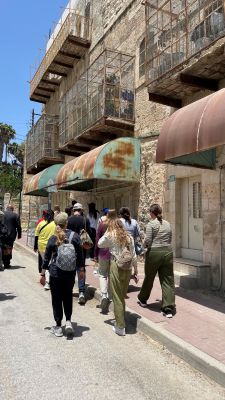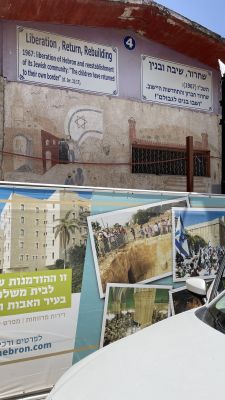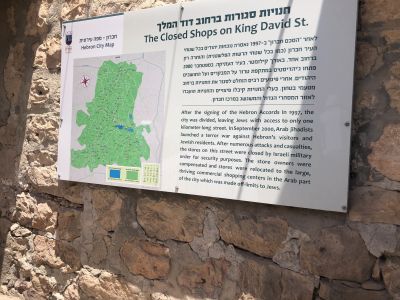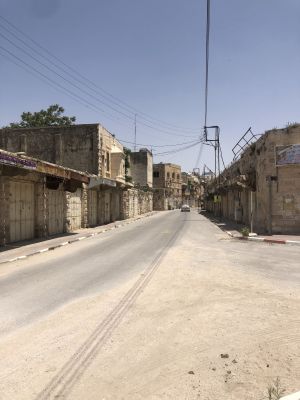“Walking in Hebron”
Rosita Lomas
Everything about this SST experience was memorable from start to finish. One of the experiences that I keep replaying in my mind was walking through Hebron and meeting with volunteers from Community Peacemaker Teams (CPT).
Walking in Hebron was one of the first times that I deeply felt the reality of the conflict. Hebron lies in the West Bank and has Israeli settlements built within the city. Before 1997, the Hebron area was controlled by Israel but on January 17, the Hebron Protocol was signed. This agreement divided Hebron into two sections known as H1, under Palestinian control, and H2, under Israeli control. There are frequent checkpoints throughout the streets as well as market areas where Palestinian shopkeepers shouted at us to buy – they seemed desperate since they receive few visitors. It all felt very different from other cities we visited.
Upon entering Shuhada Street, we were confronted with several soldiers. One soldier asked to see each of our passports. He looked at them, and then glanced at our faces. The soldier was nice and seemed happy, which did not suit the scene we were about to enter. We were all cleared to go and we continued to walk.
After the 1994 Massacre committed by Israeli-American Baruch Goldstein that happened in the Tomb of the Patriarchs/Ibrahimi Mosque, Israel restricted the movements of the Palestinian population in the area. Shuhada was one of the streets where the Israeli government shut down homes and shops, imposed a curfew on remaining residents, and restricted Palestinian-registered vehicles from entering the street.
The first thing I noticed about Shuhada was that there was no one there. It was empty. Except for the few soldiers on each corner holding their weapons, we were the only ones walking through the street along with our guide. To me, it looked like a scene that was stripped of life. I sensed fear in the air and was inclined to hear this place’s history. I don’t know if everyone else felt the same, but we were all very quiet while we took in the site.
As we walked, I glanced at all of the houses with their doors shut and secured with chains and locks. Something that I did not expect to hear was that there are still people living in some of the houses, though they are not allowed out through their front doors, so they have to crawl through back windows to get needed supplies. At this realization my feelings took a turn, and I felt guilty as I walked freely along a street where so many were not allowed.
As we walked further, we saw a sign that read “The Closed Shops on King David St.” Placards on the walls mentioned that in 2000, Arab Jihadists attacked Jewish residents, and because of this the stores along the street were closed by the Israeli military for security purposes. The narratives on the signs we passed did not resemble the narrative that our guide gave us – for example, the signs stated that shopkeepers had been paid and relocated to better locations, which our guide stated never happened. There was also no description of what is happening presently, nothing about the Palestinians still living in the streets nor the restriction of movement through the city by the Israeli military.
We ended our walk through Hebron with volunteers from a Community Peacemaker Team (CPT), an organization that supports local residents through nonviolent resistance against the Israeli occupation. With the help of international and local volunteers, the CPT aims to document and challenge oppression in Hebron, such as by accompanying Palestinian children to school as they go through multiple military checkpoints. We were told that tear gas is sometimes thrown at children for no reason at the checkpoints, and we were shown a video of a recent occurrence. This was hard for me to process because I couldn’t imagine being so little and having to face people every day with weapons and tear gas. I thought about my little brother and how worried I would be if he had to go through this every day. I thought about the little kids living in Hebron and how this is their everyday life, not being able to be kids. They are constantly worrying about how they will make it to school, unsure of what could await them.
These experiences changed the way I thought about the Holy Land because I have never witnessed so much injustice in a land that is meant to bring peace. Immediately after learning about these children, I wanted to tell people about what is happening there. I know that if more people knew about this, more people would want to help. When I came back home, I immediately told my family of what I had seen and heard. I hope that more people have the chance to experience what I have with the intention of spreading awareness.
See the CPT website for more information: https://cpt.org/programs/palestine.









